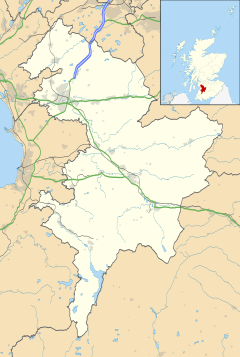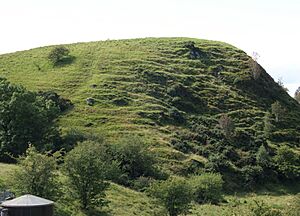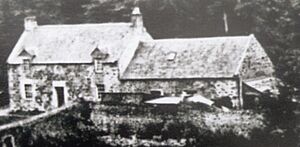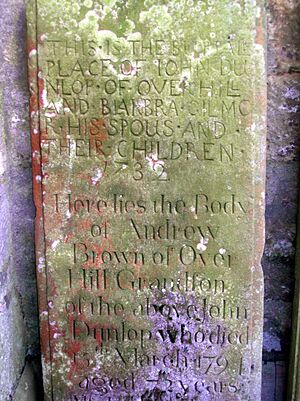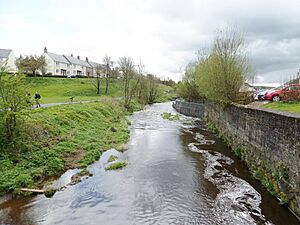Lands of Borland facts for kids
Quick facts for kids Lands of Borland
|
|
|---|---|
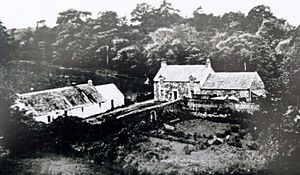 Borland circa 1900 |
|
| OS grid reference | NS398493 |
| Council area | |
| Lieutenancy area | |
| Country | Scotland |
| Sovereign state | United Kingdom |
| Post town | Kilmarnock |
| Police | Strathclyde |
| Fire | Strathclyde |
| Ambulance | Scottish |
| EU Parliament | Scotland |
The Lands of Borland were an old estate located in East Ayrshire, Scotland. They were found between Aiket Castle and the town of Dunlop. The main house of the laird (a Scottish landowner) at Borland was near the Sandy Ford, a shallow crossing point over the Glazert Water. Over time, this place has been called by many names, including Bordland, Boreland, Borland, Laigh Borland, Low Borland, and Nether Borland.
Contents
History of Borland
Old Buildings and Traditions
People have found traces of old buildings on Borland Hill. In the mid-1800s, it was noted that the foundations of a large ruin had been removed. Some people remembered seeing parts of an old wall. This suggests a significant building once stood here.
On the south side of the hill, there's a wide ditch or trench. Locals call it the 'Cuckoo slide'. This ditch might have been part of the old building's defenses.
There's a local story that the monks from Kilwinning Abbey had a special place at Borland. It was like a rest home or a hospice for them. They supposedly grew medicinal herbs in a formal garden there. This would have been a peaceful place for the monks to recover or relax.
Borland House (Laigh Borland)
An old gravestone in Dunlop graveyard mentions William Anderson and his son Robert Anderson of Borland. This shows that families lived and owned land here long ago.
Around 1823, Andrew and Mary Brown inherited the main house at Borland. It was described as "lately rebuilt" and in a "remarkably pleasant situation" by the Glazert Water. This means the house was either new or recently fixed up. The walled garden at Borland was likely built in the 19th century. Stones from the old castle might have been used to build its walls.
In the mid-1850s, Borland (then called Nether or Laigh Borland) was described as two small farmhouses. They had gardens and were in a sheltered spot by the Glazert Burn. The presence of a walled garden suggests the place was once more important than just a simple farm. Walled gardens were usually found at larger mansion houses.
The walled garden is square and has strong stone walls. Some parts were rebuilt around 1916. There were also gate piers (tall posts) at the entrance. An old sundial used to stand in the middle of the garden.
Laigh Borland house was taken down in the mid-1900s. It had become old and unsafe. There was a datestone above the entrance with the initials of the Brown family. This stone dated back to the 1500s or 1600s.
The workers' cottages nearby were thatched (had roofs made of straw) until they were demolished. A small ruined building, possibly a pigsty, can still be seen.
Over Borland Farm
Over Borland is another old farm in the area. A gravestone in Dunlop's churchyard records the deaths of John Dunlop of Over Borland and his family.
Over Borland is a historic farmhouse. It has a stone with the date '1770' carved on it. Another stone shows '1912'. This farm is one of the oldest two-story farmhouses in the Dunlop area.
It's thought that the old castle stones might have been used to enlarge Over Borland around 1770. This was possibly done to create a new main house after the original Borland house became less important.
North Borland and Other Properties
Jane Dunlop inherited the North Borland part of the estate. She and her husband, Thomas Reid, built a new house there.
Other properties like Hill (also called Over-Hill) and Borlandhills were also once part of the Lands of Borland. These lands often passed between families through marriage.
The Lairds of Borland
The 'Lairds' were the landowners of Borland. The De Ross family were the first to hold Borland or Dunlop Hill. They had a strong stone castle there. Later, they moved their main home to Corsehill in Stewarton. It's possible there was an even older Celtic hillfort on Borland Hill.
The De Ross family were 'vassals' (loyal followers) of the De Morvilles. The De Morvilles were the 'Overlords' (main rulers) of Cunninghame. Later, the lands passed to the Boyd family, and then to the Cassilis family. In the early 1600s, the Kennedys, Earls of Cassilis, owned Over and Nether Borland.
The name 'Borland' might come from the idea of wild boars living in the area. However, another idea is that 'Bordland' meant lands kept by lords to provide food for their own table.
The Lands of Borland were often held by 'Bonnet Lairds'. These were landowners who were not very rich or powerful. They wore simple hats (bonnets) like ordinary workers. Over Borland was likely the main farm connected to the Laird's house. This is supported by Borland House having a walled garden, which was usually found at larger mansion houses, not just farms.
A Historical Feud
In 1570, William and Alexander Cunninghame were involved in a conflict with John Mure of Caldwell on the Lands of Borland. They were later found not guilty.
An old story tells of a young Dunlop Laird of Hapland. He joined the Cunninghames of Aiket in a feud (a long-running quarrel) with another family. The Laird's mother had a dream that her son would die. Sadly, he was badly hurt near the Annick Water in Stewarton. His horse returned home without him.
This story seems to be about a tragic event in 1586. It was part of a long feud between the Montgomeries (Earls of Eglinton) and the Cunninghames (Earls of Glencairn). These families were competing for power. This event had big effects across Ayrshire. A Patrick Cunninghame of Bordland was involved.
It's interesting that Patrick Cunninghame later exchanged his Lands of Borland for David Dunlop's Lands of Hapland. This exchange might have been connected to the events of the feud.
Maps and Place Names
What Old Maps Show
Old maps show how the area around Borland changed over time. The main way to get to Laigh Borland was through Sandy Ford Lane. This lane went past North Borland and crossed the Glazert Water. There was also a smaller path from Over Borland.
In 1856, Laigh Borland was just called 'Borland'. Over Borland already had its current name. The walled garden was shown with paths dividing it into four sections. A small building stood at the garden's entrance. Wells were also marked on the map, providing water.
By 1895, a small pond appeared behind the walled garden. The garden no longer looked formally laid out. A footbridge was built at the ford. Another path linked Laigh Borland to the road towards Dunlop.
The 1909 map showed fewer changes. The pond was gone, and the farm cottages had fenced areas. A sundial was marked in the center of the garden.
By 1957, Laigh Borland was no longer named separately. A new road had been built from Over Borland. The old workers' cottages had been taken down.
Meanings of Local Names
The name 'Boarland' (Borland) might mean there were wild boars in the area. However, a 'Boor' also meant a serf (a type of farm worker). So, it could mean lands given to servants near a castle. Another idea is that 'Borland' or 'Bordland' meant land used to provide food for the lord's table. The name 'Borland' is part of other local names like Borlandhill, Over Borland, North Borland, and Laigh Borland.
Other local names include:
- Glazert: This river name might come from the Gaelic words glas (meaning grey or green) and dur (meaning water).
- Corsbie: This name refers to a 'cross' and has a Scandinavian ending '-by', meaning a settlement.
- Rig: A 'Rig' is a long, narrow ridge of land.
- Fox Covert: This was usually a wooded area where foxes were encouraged to live for fox hunting.
- Craig: A 'craig' is a cliff.
- Sandy Ford: This crossing point gets its name from the coarse sand found there.
Barbara Gilmour
Barbara Gilmour or Dunlop was an important person in Ayrshire in the 1600s. She introduced a new way of making cheese. This method became very popular across Ayrshire and beyond. It helped farmers and others earn more money.
Interesting Facts
- A Cunninghame from Borland was involved in a raid against Drumlanrig in 1650.
- In 1618, Gabriel Porterfield inherited several lands, including Dunlop Hill.
- Local stories say that a secret tunnel, called a Ley Tunnel, runs from the old Laigh Borland House to Aiket Castle.
- Mr 'Pop' McGaw was one of the last people to live at Laigh Borland.
- An artificial fox den, built with stones, existed in the fox covert wood. It was made to encourage foxes for hunting.
- One of the people who moved the famous Stone of Scone from Westminster Abbey in 1950 was a descendant of the Watt family from Laigh Borland.
Images for kids


